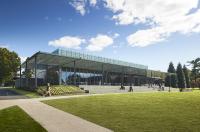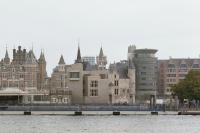Z House
Camporosso, Italië
Z House is an alpine holiday home, a place to live an intense relationship with nature and the mountains.
The site on which the house is placed is a complex place with a steep slope, access uphill, a few buildings around and full of panoramic "frameworks".
The approach path is thus one of the key points of the project, the arrival is a precise and inevitable sequence: the road climbs steeply, the house shows itself from afar in the middle of other buildings, then hides and then reappears in a scenic perspective from the bottom where you can feel the whole size of the building.
To enter inside, however, it is necessary to turn around with an obligatory, necessary path, in which the perception of the house gradually loses the built context and fits into the natural one.
During this journey of "passage" it becomes gradually smaller, the scale is reduced and from a volume of three floors then you get to a small and solitary monopiano volume, framed only by the landscape.
The choice of orientation of the views determines the plan of the house: to the west there is the access, with all the service volumes, to the east a large living area that looks into the distance towards the point where the valley continues and offers bright panoramas.
The list of functions requested by the owners is rich and complex, and it is divided into a plant with two juxtaposed volumes that are divided into sections with different heights, which follow the conformation of the land.
The large living area is located at the entrance level, and combines the two volumes into a single fluid space, while the other functions are divided: the master bedroom area is on the upper floor, overlooking the double height, while the other bedrooms, the sauna and wellness area are located on the lower floor.
This section achieves two objectives: one external and one internal. From the outside the house seems to "slip" on the ground, the ground is inclined and fluid, the house is light and does not impose terraces or other violent works on the landscape. From the inside the volume of the living area is designed by an impressive exposed concrete roof, which follows the slanting of the two volumes with different heights. It seems to enter the mountain.
The materials that make up the project reflect the basic ideas. The construction is in concrete, but it is visible only inside. The exposed concrete floors and ceilings, suspended on glass façades, accentuate the lightness of the roof.
From the outside the house is characterized by an external "skin" made of wood, like many traditional alpine architecture. Today this facade loses the traditional functions related to agriculture and breeding, and becomes a sun breaker, a necessary element of solar control and energy-saving. A fundamental architectural occasion.
The theme of lightness is guided by the design of the external sunshade (made of vertical larch blades) that surrounds the whole building, regulates the relationship with the light and the panoramas, and invents a filter space between the internal (private) world and the outside world (public).
The wooden blades have different orientations, they are sometimes rotated, the spacing is not constant. They open up to let you see and they hide and hide. They condition the internal relationship between inside and outside, and so the light vibrates and changes constantly on the outer skin of the house. It is a subtle and iridescent vibration, with the light light of the Alps.
- Architecten
- GEZA Architettura
- Locatie
- Camporosso, Italië
- Jaar
- 2016
- Klant
- private
- Team
- Arch. Stefania Anzil (project manager)
- structural design
- Ing. Alessandro D'Agostino
- mechanical design
- HT Engineering
- electrical design
- Studio Battista























